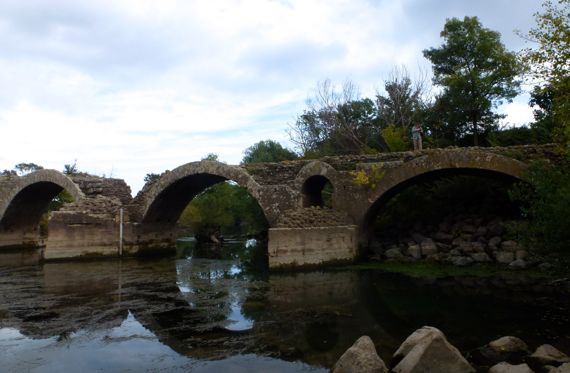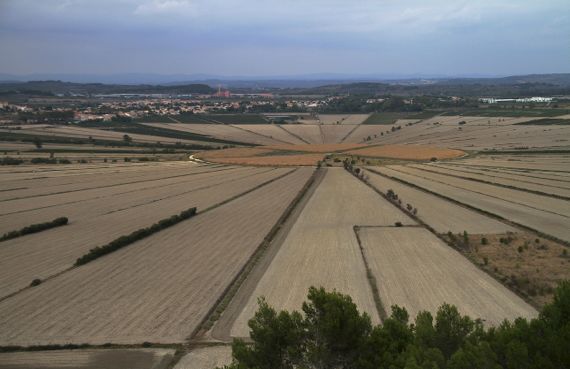Musings

Descending from the heights, like many people through history, our first stop was Saint-Jean-Pied-de-Port. Its medieval section is basically one main street, with perpendicular side streets (it’s not a hilltop town), adjacent to a river with a gorgeous little bridge. We saw school-bound kids crossing, stopping, as children will, to look in the water.
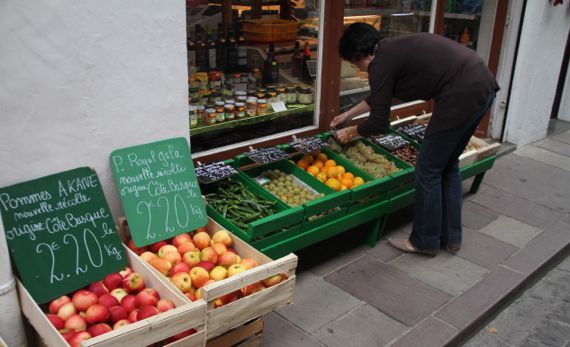
We were there early, and saw many shopkeepers opening for the day. You can tell that, although many shops catered to the tourists, people also live here—not many tourists buy apples by the kilo….
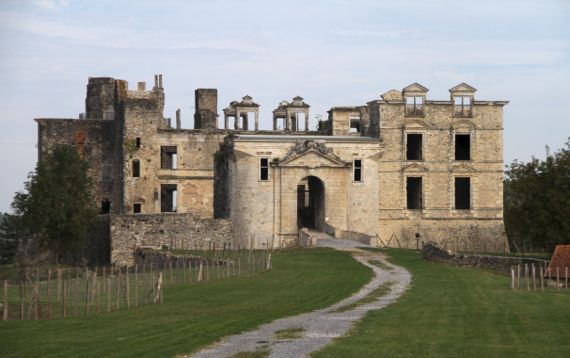
We detoured to Bidache to check out this ruined chateau. Without an appointment, we could only walk up to the front, but that by itself was pretty darned spectacular. We both found the tops of the stone window frames standing tall without their intended wall/roof partner-elements visually compelling.

How can this be last? Still, it was chronologically.
When we stood on the beach in the late afternoon, watching the surfing crowd trickle in (we theorized: after their day jobs), we knew we’d made tracks this day—from dawn in the Spanish Pyrenees to marine layer, late-day light on the Atlantic. What a great world.
Posted at 10:22 PM |
2 Comments »
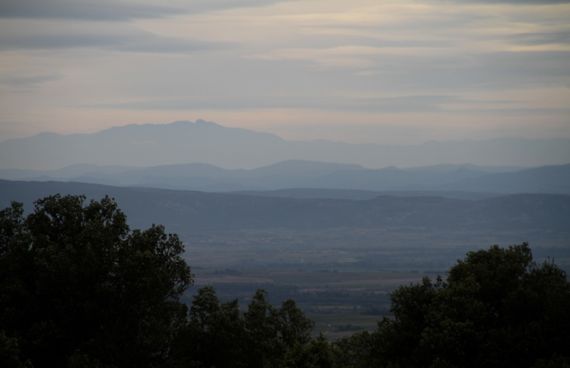
There’s a region near us, or where we’re staying now, called the Minervois, defined now as a wine region which historically was centered at Minerve. Many of the towns in this area have a version of Minerve in their names, a pattern I don’t remember from elsewhere in France. We looked in vain for a dolmen in the shrub-dominated garrigue on the ridge above town. Instead we discovered an incredible view, tinted in gorgeous shades of blue.

Several dolmen are known across the Minervois. This one is called Dolmen des Fades (or some variation thereof). Dolmen are, at least in the original definition, Neolithic-period megalithic tombs built across a broad swath of Europe. Seems to me that most of them are “empty” by now. We could tell there was quite a bit of reconstruction on this one, but the big stones did not appear to be from this hill. That’s a quick assessment, though.
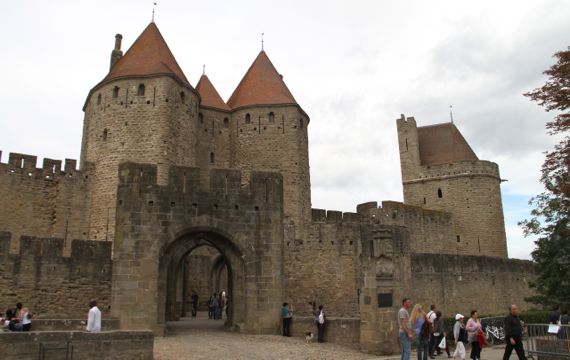
A bit later, we arrived at the east gate of the Cité, the fortified old town of Carcassonne (history in summary here and detailed here). The fortification has (at least) double walls, many towers and shooting positions, and encloses a separate fortified chateau (had a moat? now filled?)—look here (43.20731,2.36313).
I haven’t mentioned the Canal du Midi—we saw it yesterday (near Beziers first), and have been seeing it here and there as we cruise the countryside. Okay, here are the boaters at Homps, the “port” for Olonzac (our present home). The canal was built to facilitate a shipping route that avoided the Iberian coast, including the Barbary pirates.

I knew I could get us back to the political economy.
Posted at 12:26 PM |
Comments Off on Variability: Minervois, a megalith, a mega-fortification, canal
We revisited the Via Domitia. There’s a later mill immediately upstream from the remains of this structure. We saw pretty small fishies in the water, and slightly larger fishies keeping them company. Seems like there should have been even larger ones, but we didn’t see them.
This is the strangest anti-irrigation engineering feat I can remember encountering anywhere. These radiating (actually pointing inward) canals brought water to the center of this circular area, sending the flow out through a drain, making a large marshy area useful for agriculture. This was done in the…13th C. I can’t tell who masterminded this project, or who funded it.
Posted at 12:22 PM |
Comments Off on Water problems solved
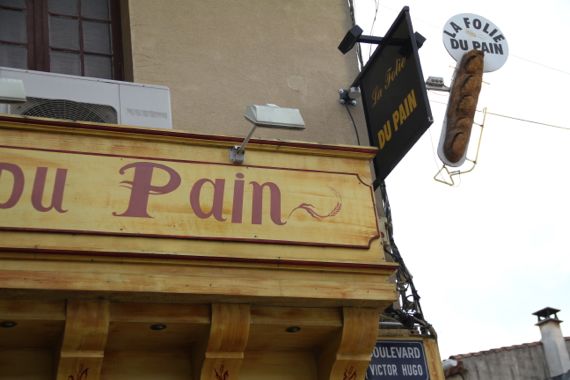
Reminder: pain in French means terrific bread; it is not painful to eat!
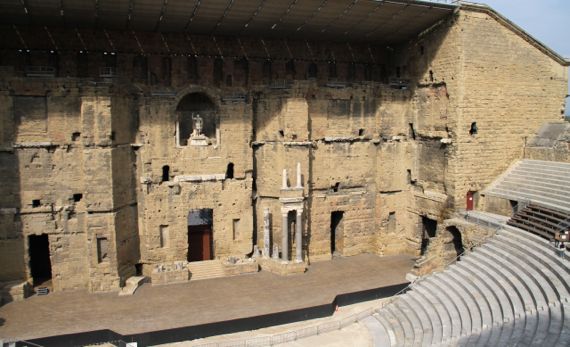
By the time this was built, estimated to be between AD 10 and 25, the Romans aimed to construct a complete architectural façade against which to stage their theatrical performances. As I understand it, the thrust of this was not only to be massive (see the tiny people to the far right of the frame) but to promote their vanquishing of this region. The formal name these days of this wonder is Théâtre antique d’Orange, and it is one of two that survive in this detail. Back in Roman days entrance was free; today you pay (that’s okay, your funds support maintenance), plus have to exit a winding trail through their junk shoppe.
Posted at 10:22 PM |
Comments Off on Of bread and…not quite circuses
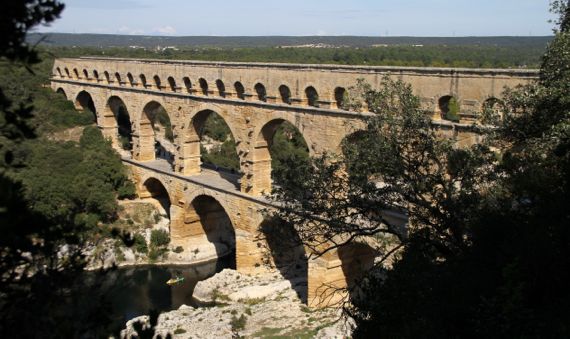
Stunning. This aqueduct, the Pont du Gard had a drop of 12.83 meters over the 50-km length of the run between the spring that fed it (we tried to get there and couldn’t—private property) and the catchment in Nîmes. The Romans of Nemausus wanted more water, and this is how they got it.
By observation, we would note that single kayaks, like this, carried quiet people, but if the kayaks passed by in clusters, yikes!—the noise.
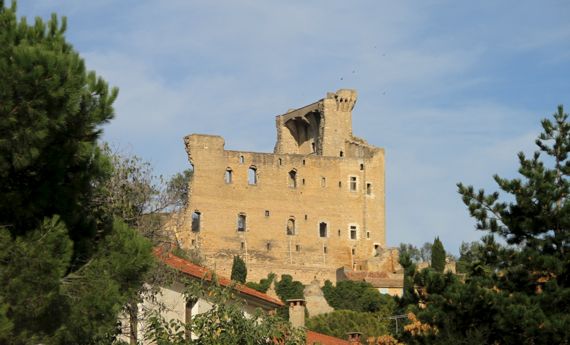
Châteauneuf-du-Pape is so named because the popes of Avignon came here back in the 1300s and developed grape-growing to have wine for their tables and to “share.” Now it is quite the wine center, with tasting places frequently encountered, both in town and along the feeder roads. The castle looming over town is a shell of its former self. The upper level has what look like machicolations that resemble those of the gothic Palais des Papes in Avignon.
Posted at 1:10 PM |
1 Comment »
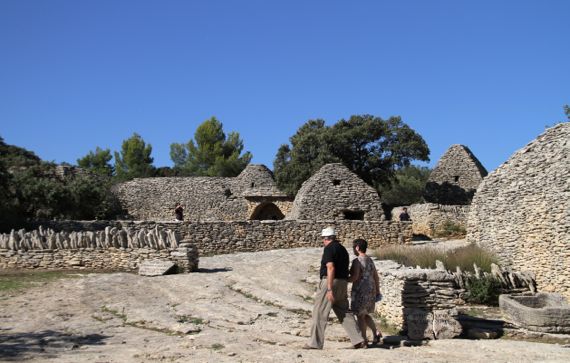
If you chose to live on a limestone deposit that will break into flat stones, you have the perfect material to make…corbeled-arch buildings. Around here, these are called bories, and the village of Gordes has several hundred to the west of downtown, a small cluster of which were restored in the early 1970s, and are now owned by the town. The earliest in this cluster date to the 1400s, but the oldest known date to well before Christ. I believe this cluster was abandoned early in the 20th C. Anyway, they’re quite…interesting.
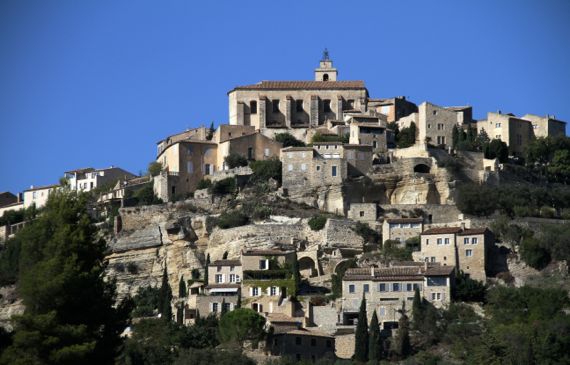
If you have a medieval mentality, you build on top of hills, and put your church on the highest ground. (Or maybe you command the populace to do so.) Terracing works to hold the slope yet make the steep terrain useful. Worldwide.

We wandered the small town square of Oppède-les-Poulivets (43.84360,5.16855), with about a dozen parked cars, and caught some nice late-afternoon light shots. Then a local bus arrived, and a bunch of kids got off, headed for the cars, and within three minutes, most of the cars had disappeared.
Posted at 10:22 PM |
1 Comment »
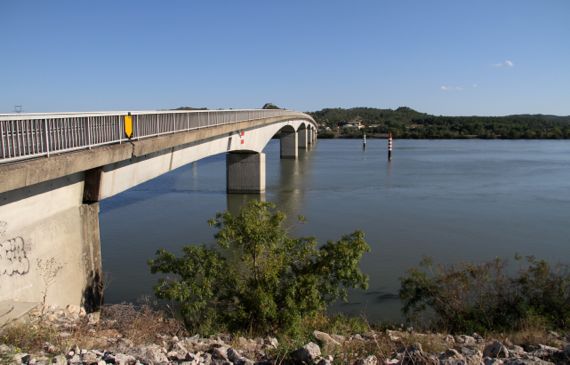
I keep thinking about the Rhône, and we keep visiting its environs, but I have yet to SHOW you the Rhône. So, here it is. A bridge downstream of Avignon—we were avoiding the afternoon traffic through town….
On our way back from…Ambrussum.
This is a Roman hillfort and surrounding community that basically was not trashed by later occupation. So rare.
Also, except for some foundation walls and part of the city-wall, there’s been no reconstruction here. I like that.
We had a hot walk (no rain today!) up the hill and on the trail, mostly looking at limestone chunks, with scattered sherdlets among the stone-crud. Parts of the trail followed the old Roman cobblestone ways.
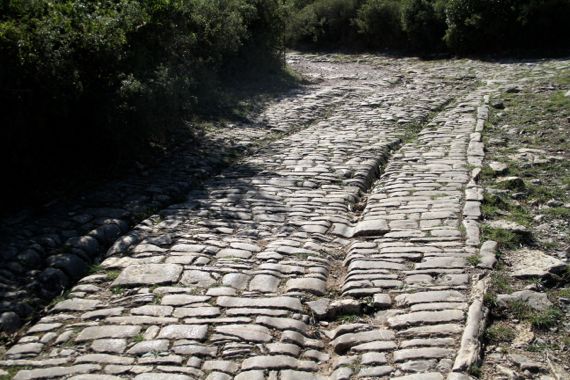
The interpretation is that these cart-wheel wear patterns date to Roman times. Given the layer of overburden and lack of medieval/later occupation here, I’d buy that.
This hillfort is immediately adjacent to the River Vidourle, although the fortified area is a slog above the river. Still, the community needed a bridge to be effective in controlling trade, and so it was.
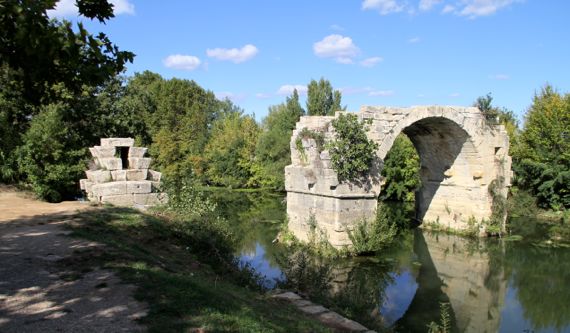
The bridge, Pont Ambroix, had a second standing arch maybe a century ago, the arch that connected to this bank. If you look into the water, you can see the large blocks that must have been part of the bridge, including on the other side of the standing arch. The vegetation growing among the stones doesn’t help preservation, either….
Ambrussum and other places we plan to visit as we proceed west are along the Via Domitia, the section of Roman road that went west from the Torino area (Po Valley, northern Italy), crossed the Alps, and dropped down to the upper Lower Rhône area, then went west paralleling the seacoast, and into the Pyrenees.
Title credit to The Guru.
Posted at 1:18 PM |
4 Comments »
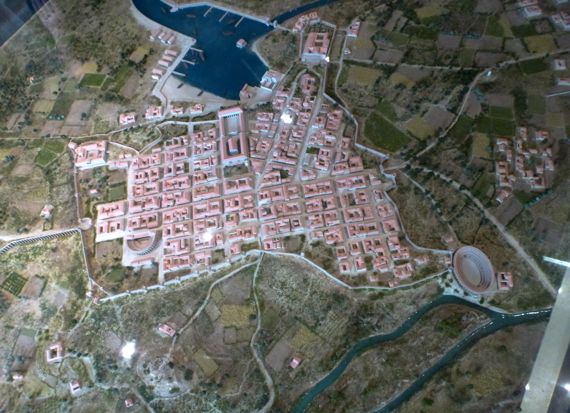
Diorama of Roman-period buildings in what is now Fréjus, known then as Forum Julii. Note the amphitheater (43.43438,6.72883), locally called the Arènes, and theater (43.43695,6.73811)—both survive. I’m standing on the “north” side, so you may consider this view “upside down.”
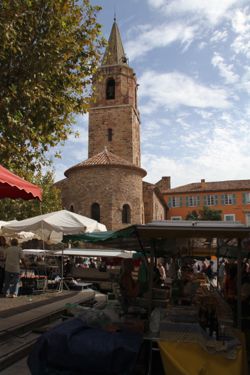
As is common in these parts, the medieval town of Fréjus is atop the Roman town. Here, though, archaeologists have had more of a chance than normal to delve into the Roman remains. Check out the boat basin (43.43122,6.74033), the economic hub of the community. It was silted in within centuries after the Romans faded from France, but, since it’s still low-lying, is now mostly open land, and almost perfectly bisected by a RR grade. A portion of a city gate/wall survives at the edge of it.
We enjoyed the hustle-bustle of market day, and I certainly wished I had a kitchen to retire to, and could justify buying the fine fish, cauliflower, fruits, and more that vendors offered in enticing displays on the west side of the church—but not in the plaza to the south (don’t know why).
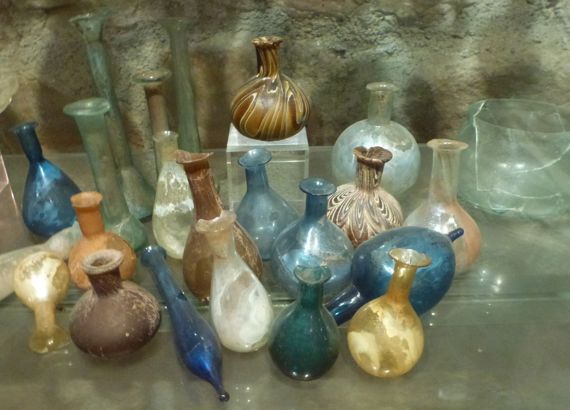
We very much enjoyed the small, high-quality archaeological museum, tucked around the north side of the church. These elegant perfume bottles testify to the fine-points of the Roman toilette, if you could afford such.
I consider Fréjus a lucky stop for us. We left our morning B&B in rain, drove in rain, but Fréjus was clear and even sunny. After we got back on the highway, we went through more rain. Lucky us, it was clear and sunny again by the time we got to our “new” B&B, where we’ll be for days. And nights.
We’re indulging here, and have paid for half-board, which means we go to dinner, four courses, just downstairs. Wine extra (duh!). Tonight: beef carpaccio with shaved parmesan, fresh basil and petit salade; fruits de mer (steamed or simply cooked fish, five kinds, one prawn) with lemon couscous served in a cream sauce that couldn’t be topped; fromage assortment; and sherbet trio (melon, red we couldn’t figure out, third I never figured out—all delicate and delicious) in a baked bowl made from two squares of filo, making a crunchy complement to the sherbet and two raspberries.
Posted at 10:22 PM |
2 Comments »
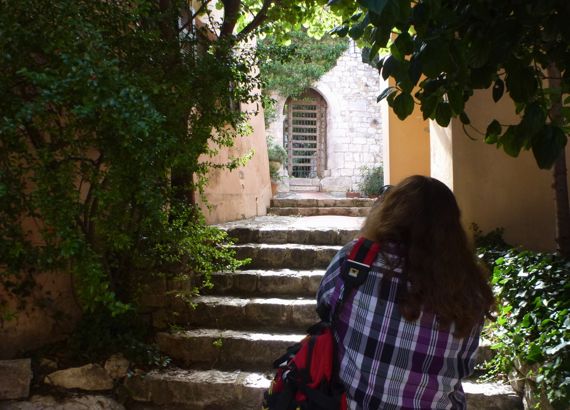
I am standing in the path of the Roman road that lead west from Rome skirting the coast of the Mediterranean. I think I read that this was the highest place along that route, which eventually went all the way to Spain. I am standing here (43.74522,7.40151), shooting south toward the gate that is some kind of post-medieval retread, and I suspect there was no gate here in Roman times. Anyway, just south of that gate is a 1930s reconstruction of a c. 6 BC piss-mark monument that has many names today. It celebrated the conquering by Augustus of many indigenous peoples living in the zone that today spans the French-Italian border in the southern Alps (a border which moved even in modern times). In case any subjects considered rebellion or otherwise forgot their place, this structure loomed above them at every turn, reminding them who the bosses were. The reconstruction dates to the 1930s. The original was robbed for building stones certainly during medieval times and probably before. The Roman stamp faded and the rebels could reassert themselves….
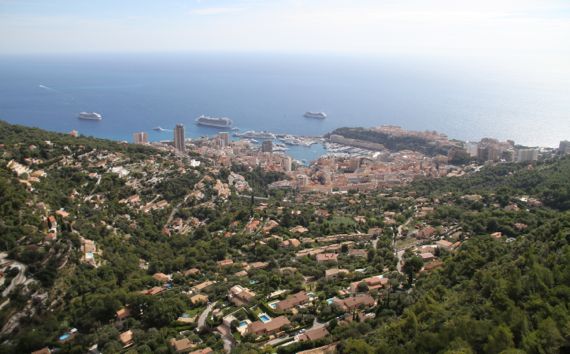
Standing here (43.74547,7.40345), on the end of a promenade the locals call the rondo, with carefully tended tiny plots of lawn and shrubbery and a rock noting that the Mayor of La Turbie made Prince Rainier an honorary citizen not too long ago, we looked down on the heart of Monaco.
Between us and the harbor, and just above the water, is the part of town where the famed casino is (we didn’t bet a penny, euro, or any other currency). That peninsula jutting out framing the other side of the harbor is the old part of town, Monaco-Ville, where the Prince’s Palace is (it’s the higher roof, of course). Since this is a politically independent place, I’d rather expect the top royal would be a king/queen, but, as you’re probably aware, that’s not the case. I’m sure the reason for this is noted somewhere, but I have either missed it or haven’t retained it.
After gazing out to sea for quite a while, and enjoying the breeze, we walked back to the car through the narrow winding streets, partly on the old Roman route, then drove down into Monaco, notching a third country on our belt for the trip so far (France, Switzerland, and…).
We, being mere colonials, had the idea that we could loop around Monaco-Ville, but a police-security guy was posted to deflect tourist cars from doing so. We opted not to walk there, either, and headed toward Nice on the basse corniche, the lower of the three along the stretch between Monaco and Nice.
In Nice, we skipped the Terra Amata site and museum (yes, very famous and Late Paleolithic, but), and did wander the Gallo-Romaine museum/ruins of Roman Cemenelum (more info here, on the dot-fr page; let Google translate help you), confusingly called Cimiez in all the off-site signage. The exposed zone has two bath complexes (different dates), sections of streets, and so on (check 43.71893,7.27610 in satellite view).
Fun day!
Posted at 3:02 PM |
1 Comment »
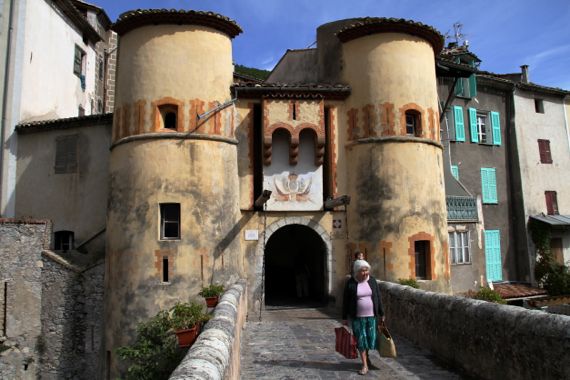
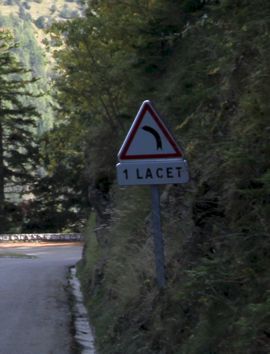
Carrying her loaded market bags, this local lady is headed…I dunno, to visit her sister? She’s crossing the bridge from the medieval section of Entrevaux to newer occupations across this defensible walkway. Note that right before the towers is a drawbridge (squint), of strong oak planks. I don’t know how often it is raised these days….
In these parts, a lacet is a shoelace. In this context, lacet means hairpin turns. I traveled (with the Guru driving) along more lacets today than any other day in my life. Please note that although we saw the highest road in Europe, we didn’t embark upon it (let alone traverse it). The roads we did traverse were plenty high and serpentine. Grazed the treeline, saw evidence of storms that came through about two days ago, but no trees across our path (whew!).
Thanks, readers! I’m heartened that you request MORE photos. The last B&B we stayed at had…limited internet service, so what I did post was a stretch. Today, well, I’m just plain tired. The upshot is, teeeheee, I get to show you more photos when I see you next!
Posted at 4:21 PM |
3 Comments »








